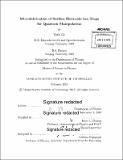| dc.contributor.advisor | Isaac L. Chuang. | en_US |
| dc.contributor.author | Ge, Yufei, S.M. Massachusetts Institute of Technology | en_US |
| dc.contributor.other | Massachusetts Institute of Technology. Department of Physics. | en_US |
| dc.date.accessioned | 2015-10-14T15:02:56Z | |
| dc.date.available | 2015-10-14T15:02:56Z | |
| dc.date.copyright | 2015 | en_US |
| dc.date.issued | 2015 | en_US |
| dc.identifier.uri | http://hdl.handle.net/1721.1/99280 | |
| dc.description | Thesis: S.M., Massachusetts Institute of Technology, Department of Physics, 2015. | en_US |
| dc.description | Cataloged from PDF version of thesis. | en_US |
| dc.description | Includes bibliographical references (pages 123-132). | en_US |
| dc.description.abstract | Trapped ions are a promising approach to quantum computation. This approach uses a qubit state which is the atomic state and quantum motional state of a trapped ion to encode information, and uses laser-ion interactions to manipulate the qubit state. A major obstacle to the realization of a practical ion trap quantum computer is decoherence. In trapped ion quantum computation experiments, decoherence is dominated by the uncontrolled heating of ion motional states. In this thesis, we present the detailed microfabrication of several series of surface electrode linear Paul traps made from different electrode materials, followed by the ion motional heating experiment results for these traps. We demonstrate that the ion motional heating strongly depends on fabrication process. In particular, we explore how grain size and grain orientation affect the ion motional heating rate. This thesis is divided into two parts. In the first part, we describe the fabrication of gold, silver, aluminum and niobium traps from different processes, which results in various surface morphologies and grain structures. Ion motional heating rate measurements are then conducted both at cryogenic temperatures and at room temperature. We employ a physical model based on the fluctuating patch potential theory to explain the ion heating behavior. We use gold traps to study the temperature and frequency dependence of the ion heating. We use aluminum traps to study the ion heating dependence on the amorphous dielectric layer. And we use silver traps to study the ion heating dependence on the grain structure. These results suggest that excess ion heating could possibly be suppressed by suitable fabrication selection. In the second part, we present the process of using SU8 to fabricate a multilayer surface electrode point Paul trap, which has the advantage of allowing ion height variation within the same trap and enables testing of the distance dependence of ion heating. | en_US |
| dc.description.statementofresponsibility | by Yufei Ge. | en_US |
| dc.format.extent | 132 pages | en_US |
| dc.language.iso | eng | en_US |
| dc.publisher | Massachusetts Institute of Technology | en_US |
| dc.rights | M.I.T. theses are protected by copyright. They may be viewed from this source for any purpose, but reproduction or distribution in any format is prohibited without written permission. See provided URL for inquiries about permission. | en_US |
| dc.rights.uri | http://dspace.mit.edu/handle/1721.1/7582 | en_US |
| dc.subject | Physics. | en_US |
| dc.title | Microfabrication of surface electrode ion traps for quantum manipulation | en_US |
| dc.type | Thesis | en_US |
| dc.description.degree | S.M. | en_US |
| dc.contributor.department | Massachusetts Institute of Technology. Department of Physics | |
| dc.identifier.oclc | 922869995 | en_US |
